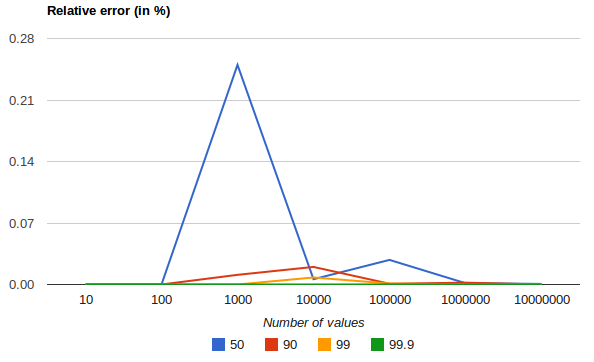WARNING: Version 1.7 of Elasticsearch has passed its EOL date.
This documentation is no longer being maintained and may be removed. If you are running this version, we strongly advise you to upgrade. For the latest information, see the current release documentation.
Percentiles Aggregation
editPercentiles Aggregation
editA multi-value metrics aggregation that calculates one or more percentiles
over numeric values extracted from the aggregated documents. These values
can be extracted either from specific numeric fields in the documents, or
be generated by a provided script.
This functionality is in technical preview and may be changed or removed in a future release. Elastic will work to fix any issues, but features in technical preview are not subject to the support SLA of official GA features.
Percentiles show the point at which a certain percentage of observed values occur. For example, the 95th percentile is the value which is greater than 95% of the observed values.
Percentiles are often used to find outliers. In normal distributions, the 0.13th and 99.87th percentiles represents three standard deviations from the mean. Any data which falls outside three standard deviations is often considered an anomaly.
When a range of percentiles are retrieved, they can be used to estimate the data distribution and determine if the data is skewed, bimodal, etc.
Assume your data consists of website load times. The average and median load times are not overly useful to an administrator. The max may be interesting, but it can be easily skewed by a single slow response.
Let’s look at a range of percentiles representing load time:
By default, the percentile metric will generate a range of
percentiles: [ 1, 5, 25, 50, 75, 95, 99 ]. The response will look like this:
{
...
"aggregations": {
"load_time_outlier": {
"values" : {
"1.0": 15,
"5.0": 20,
"25.0": 23,
"50.0": 25,
"75.0": 29,
"95.0": 60,
"99.0": 150
}
}
}
}
As you can see, the aggregation will return a calculated value for each percentile in the default range. If we assume response times are in milliseconds, it is immediately obvious that the webpage normally loads in 15-30ms, but occasionally spikes to 60-150ms.
Often, administrators are only interested in outliers — the extreme percentiles. We can specify just the percents we are interested in (requested percentiles must be a value between 0-100 inclusive):
{
"aggs" : {
"load_time_outlier" : {
"percentiles" : {
"field" : "load_time",
"percents" : [95, 99, 99.9]
}
}
}
}
Script
editThe percentile metric supports scripting. For example, if our load times are in milliseconds but we want percentiles calculated in seconds, we could use a script to convert them on-the-fly:
{
"aggs" : {
"load_time_outlier" : {
"percentiles" : {
"script" : "doc['load_time'].value / timeUnit",
"params" : {
"timeUnit" : 1000
}
}
}
}
}
|
The |
|
|
Scripting supports parameterized input just like any other script |
The script parameter expects an inline script. Use script_id for indexed scripts and script_file for scripts in the config/scripts/ directory.
Percentiles are (usually) approximate
editThere are many different algorithms to calculate percentiles. The naive
implementation simply stores all the values in a sorted array. To find the 50th
percentile, you simply find the value that is at my_array[count(my_array) * 0.5].
Clearly, the naive implementation does not scale — the sorted array grows linearly with the number of values in your dataset. To calculate percentiles across potentially billions of values in an Elasticsearch cluster, approximate percentiles are calculated.
The algorithm used by the percentile metric is called TDigest (introduced by
Ted Dunning in
Computing Accurate Quantiles using T-Digests).
When using this metric, there are a few guidelines to keep in mind:
-
Accuracy is proportional to
q(1-q). This means that extreme percentiles (e.g. 99%) are more accurate than less extreme percentiles, such as the median - For small sets of values, percentiles are highly accurate (and potentially 100% accurate if the data is small enough).
- As the quantity of values in a bucket grows, the algorithm begins to approximate the percentiles. It is effectively trading accuracy for memory savings. The exact level of inaccuracy is difficult to generalize, since it depends on your data distribution and volume of data being aggregated
The following chart shows the relative error on a uniform distribution depending on the number of collected values and the requested percentile:

It shows how precision is better for extreme percentiles. The reason why error diminishes for large number of values is that the law of large numbers makes the distribution of values more and more uniform and the t-digest tree can do a better job at summarizing it. It would not be the case on more skewed distributions.
Compression
editApproximate algorithms must balance memory utilization with estimation accuracy.
This balance can be controlled using a compression parameter:
{
"aggs" : {
"load_time_outlier" : {
"percentiles" : {
"field" : "load_time",
"compression" : 200
}
}
}
}
The TDigest algorithm uses a number of "nodes" to approximate percentiles — the
more nodes available, the higher the accuracy (and large memory footprint) proportional
to the volume of data. The compression parameter limits the maximum number of
nodes to 20 * compression.
Therefore, by increasing the compression value, you can increase the accuracy of
your percentiles at the cost of more memory. Larger compression values also
make the algorithm slower since the underlying tree data structure grows in size,
resulting in more expensive operations. The default compression value is
100.
A "node" uses roughly 32 bytes of memory, so under worst-case scenarios (large amount of data which arrives sorted and in-order) the default settings will produce a TDigest roughly 64KB in size. In practice data tends to be more random and the TDigest will use less memory.